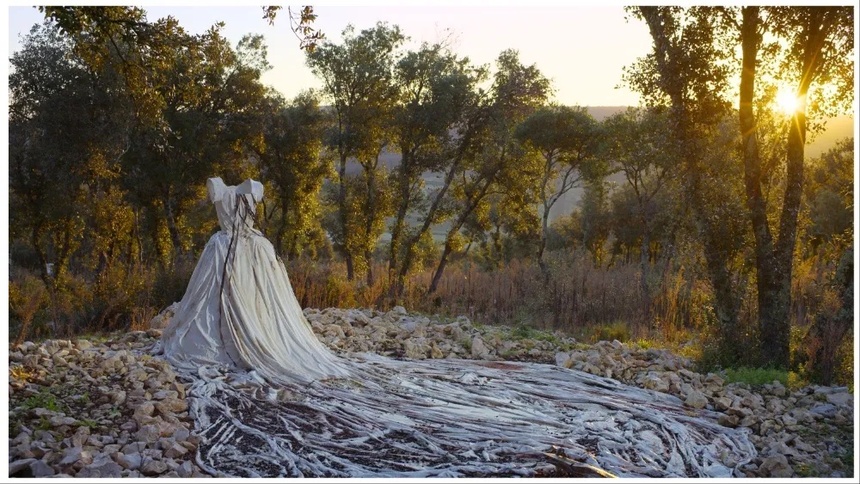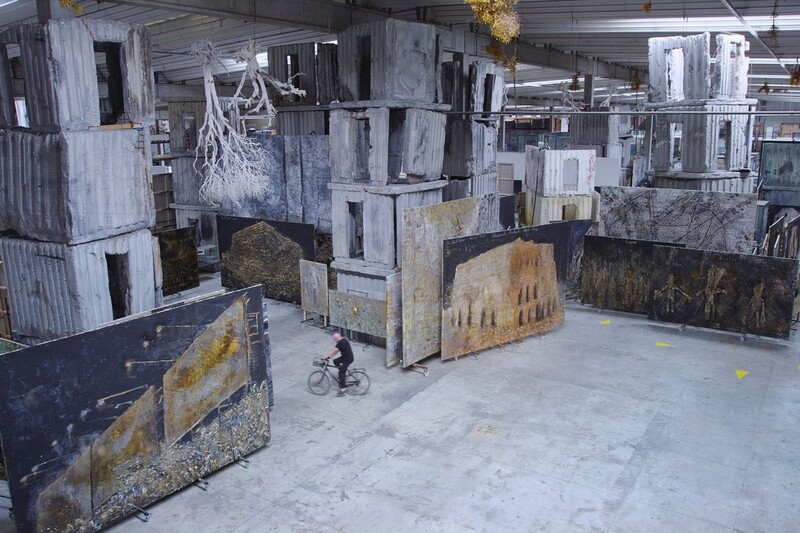ANSELM Review: Art, and an Artist, Larger than Life

An observation rather than an analysis; a retrospective rather than a perspective. Wim Wenders' new documentary Anselm, about famed German artist Anselm Kiefer, is not the love letter and celebration of his previous (and superior) artist documentary Pina, but it's still a tribute to an artist who has had a large effect on the art world. As large as the physical dimensions of his work.
We begin the fields, the landscape which has been at the heart of Kierfer's work for most of his career: white ball gowns kept upright with metal frames, often with objects where heads would be. Art as a part of the natural world. Wenders then takes us to Kiefer's current atelier - a space so large the artists uses a bicyle to traverse the space. We see the artist as he reads through books that have inspired him talks about once of his greatest inspirations, the poet Paul Celan, and how his interest in Heidegger, German history caught his attention. As well as his upbringing in a Germany devastated by WWII, and reckoning with the nation's role in genocide.
It's hard not to be amazed at the scale of Kiefer's work: huge canvases, covered with paint, with liquified metal, with hay that has been burnt. And to watch the artist create this tableaus, along with a crew of assistances. The literaly sweat and proverbial blood that creates paintings that feels like they sound a tremendous gong, impossible not to feel small next to, and yet they showcase what humans create - a golden darkness that shows both the lights and the terrors in the human soul.
Much of Kiefer's fame comes his work that examines much of German history and philosophy; he once did a performance art series where he photographed himself in various landscapes posing with a 'seig heil' salute, for example, and much of his other work in the 60s and 70s was criticized for referring to subjects and persons often revered by the Nazis. Wenders touches on this - it would be impossible not to - but doesn't linger too long. Kiefer repeats what he has likely said numerous times - an examination of these does not equate support, and certainly it helps nothing to ignore uncomfortabel history. But it's also easy for him to do this, as a very privileged person, without serious backlash.
His position has allowed him to create this kind of almost industrial art - not to say it has no place as art, it most definitely does. Whether it be a painting of the German landscape at dawn or a city street; whether it be large sculpture of angel wings or a column of books. He incorporates metal, hay, clay, all different sorts of materials into his work. It's frequently fascinating to see how his imagination stretches to incorporate anything and everything that can bring about his vision.
Wenders mostly places the camera at a distance so we can observe Kiefer and his team as they work, showing the sheer size of the work, and how art can be impactful not only in a gallery, but in the world. Watching it in 3D brings it that much more to life, allowing you to feel the weight of the canvas, the touch of the paper and brush, or the heat coming off the flamethrower as he burns hay to a canvas. The seeming neutrality of the camera belies the activivity it encourages in the viewer - perhaps this is how we should always view art.
Anselm is certainly an engaging film, both for those familiar with and new to the artist. The 3D option does its job to immerse the viewed in the artist's world, helping us to feel the materiality of artistic construction that puts us, if not in the artist's shoes, at least beside him, in understanding the complexity of the creation process.
Amselm opens in Canada on December 22nd, and is currently screening in the USA.
Anselm
Director(s)
- Wim Wenders
Cast
- Anselm Kiefer
- Daniel Kiefer
- Anton Wenders







